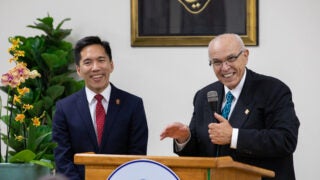USC ‘digital archaeological dig’ seeks families of Nisei students, 80 years after Japanese incarceration
The university will posthumously honor students banished during wave of anti-Japanese sentiment after Pearl Harbor — but first it has to find them.
Digitized images of handwritten records, photos and correspondence are helping university leaders identify students forced to leave USC in 1942. Ghosts leave few clues, but a determined university effort is under way to right a historic wrong and find descendants.
USC Registrar Frank Chang deciphers academic hieroglyphs on sight. A jumble of seemingly mysterious abbreviations and digits, augmented with handwritten symbols, can tell him what courses a student completed based on a digitized image of a 1941 transcript. Those images vary in clarity and quality. Smudges and transfers to microfiche and digital formats have blemished them over time.
“It’s like a digital archeological dig,” Chang said. “With the bits and pieces we have, we can confirm when some of these students attended, when and where they were born, and in some cases their course of study. But there are missing links.”
Righting historical wrongs against Nisei students
Chang and his team of staff members and student workers are part of a historic and unprecedented effort to issue honorary posthumous degrees to USC’s Nisei students, scholars born in the U.S. to Japanese American parents. Those students, along with virtually all Japanese American families in the western part of the country, were sent to incarceration camps in the winter months after Pearl Harbor was bombed on Dec. 7, 1941.
Though many were able to continue their education at other colleges and universities, they did so without support from USC: Unlike other western universities, USC refused to provide transcripts needed for transfer.
It’s estimated about 121 Nisei students were forced to leave USC in 1942 after the attack on Pearl Harbor. Anti-Japanese sentiment led to the displacement of over 120,000 Japanese-Americans into incarceration camps.
A handful received honorary degrees a decade ago. With most born between 1915 and 1921, it’s believed most have passed away.
A decision by President Carol L. Folt to award posthumous honorary degrees to Nisei students was announced in October. The degrees will be awarded on April 1, giving the university just a few months to complete its quest for the eligible students whose families could claim the degrees.
Since the announcement, the university has received almost 30 submissions naming potentially eligible candidates. The effort to locate and verify Nisei students is a joint project that includes the offices of the President, Provost and Registrar. The Asian Pacific Alumni Association, headed by Grace Shiba, is on the front lines of the search.
It’s so important to bring them here next spring to receive the honorary degrees in the spirit of reconciliation.
Grace Shiba
Asian Pacific Alumni Association
“We’re working as quickly as we can to identify our Nisei students, and many of their families are in touch with USC,” Shiba said. “We’re focused on finding the remaining families. It’s so important to bring them here next spring to receive the honorary degrees in the spirit of reconciliation.”
Hunting for clues to Nisei ancestors
In much the same way that Chang studies academic records, Shiba sorts through lists, photos, letters and stories. There’s a list of Nisei students who received honorary alumni certificates in 2008. An invaluable 1942 edition of El Rodeo, USC’s yearbook, provides photos and membership lists of the Japanese Trojan Club and other student groups. Archived correspondence seeking student transcripts from the fall of 1942 listed more than a dozen USC Nisei student names.
Anecdotal evidence from family accounts and community groups lends support, and Shiba values records from Gakusei Kai House, which at the time housed Japanese American students.
“We have a strong sense of who our Nisei students are,” Shiba said. “We’re inspired to keep looking so these honorary degrees, so well deserved, can be placed in the hands of the descendants of those who were denied.”



